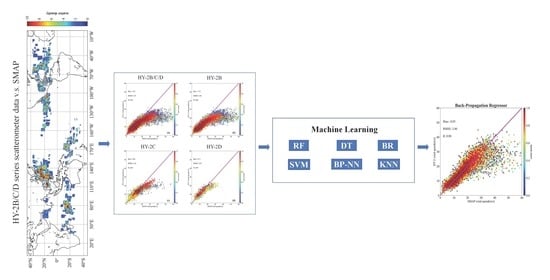Evaluation and Calibration of Remotely Sensed High Winds from the HY-2B/C/D Scatterometer in Tropical Cyclones
Abstract
1. Introduction
2. Datasets
2.1. HY-2 Series Scatterometer Data of High Wind Speed Vectors
2.2. SMAP Radiometer Data in Tropical Cyclones
2.3. High Wind Speed Measurements from SFMR
3. Methods
3.1. ANN
3.2. SVM
3.3. KNN
3.4. Decision Tree and Random Forest
3.5. Bayesian Ridge Regression
3.6. Method of Machine Learning
4. Results
4.1. Collocations of HY-2B/C/D and SMAP
4.1.1. Geographical Distribution
4.1.2. Tropical Cyclones Jointly Captured by HY-2 and SMAP
4.2. Statistical Analysis of HY-2 Scatterometer and SMAP Radiometer
4.3. A Revised Algorithm Based on Machine Learning
4.3.1. Implementation of Machine Learning Algorithms
4.3.2. Evaluation of Machine Learning Algorithms
4.4. Comparisons of Revised Winds and SFMR Winds
5. Conclusions
Author Contributions
Funding
Data Availability Statement
Conflicts of Interest
References
- Katsaros, K. Microwave Remote Sensing of Tropical Cyclones from Space. J. Oceanogr. 2002, 58, 137–151. [Google Scholar] [CrossRef]
- Xu, X.; Dong, X.; Zhu, D.; Lang, S. High Winds From Combined Active and Passive Measurements of HY-2A Satellite. IEEE J. Sel. Top. Appl. Earth Observ. Remote Sens. 2018, 11, 4339–4348. [Google Scholar] [CrossRef]
- Lin, M.; Zou, J.; Xie, X.; Zhang, Y. HY-2A Microwave Scatterometer Wind Retrieval Algorithm. Eng. Sci. 2013, 68, 68–74. [Google Scholar]
- Lin, M.; Jiang, X. HY-2 Ocean Dynamic Environment Mission and Payloads. In Proceedings of the 2014 IEEE Geoscience and Remote Sensing Symposium, Quebec City, QC, Canada, 13–18 July 2014; pp. 5167–5170. [Google Scholar] [CrossRef]
- Lin, M.; Zhang, Y.; Yuan, X. The Development Course and Trend of Ocean Remote Sensing Satellite. Acta Oceanol. Sin. 2015, 37, 1–10. [Google Scholar] [CrossRef]
- Yun, T.; Dong, X. Study of Image Reconstruction Techniques for Spaceborne Scatterometer. Remote Sens. Technol. Appl. 2015, 30, 495–503. [Google Scholar] [CrossRef]
- Li, Y.; Min, J.; Rui, Y.; Chen, W. System Design of Microwave Radiometer of HY-2A satellite. Eng. Sci. 2013, 15, 39–43. [Google Scholar] [CrossRef]
- Dong, X.; Lang, S.; Wang, T.; Liu, H. Accuracy and Resolution Analysis of the Pencil Beam Radar Scatterometer Onboard China’s HY-2 Satellite. In Proceedings of the 2007 IEEE International Geoscience and Remote Sensing Symposium, Barcelona, Spain, 23–28 July 2007; p. 44674470. [Google Scholar] [CrossRef]
- Jiang, X.; Wang, X. The Technology of Precise Orbit Determination for HY-2A Satellite. Eng. Sci. 2013, 15, 19–24. [Google Scholar]
- Xu, X.; Xu, K.; Wang, Z.; Liu, H.; Wang, L. Compensating the PTR and LPF Features of the HY-2A Satellite Altimeter Utilizing Look-Up Tables. IEEE J. Sel. Top. Appl. Earth Observ. Remote Sens. 2015, 8, 149–159. [Google Scholar] [CrossRef]
- Zhang, Y.; Lin, M.; Song, Q. Evaluation of Geolocation Errors of the Chinese HY-2A Satellite Microwave Scatterometer. IEEE Trans. Geosci. Remote Sens. 2018, 56, 6124–6133. [Google Scholar] [CrossRef]
- Zhang, L.; Yu, H.; Wang, Z.; Yin, X.; Yang, L.; Du, H.; Li, B.; Wang, Y.; Zhou, W. Evaluation of the Initial Sea Surface Temperature From the HY-2B Scanning Microwave Radiometer. IEEE Geosci. Remote Sens. Lett. 2020, 18, 137–141. [Google Scholar] [CrossRef]
- Martin, S. An Introduction to Ocean Remote Sensing: Passive Microwave Observations of the Atmosphere and Ocean Surface; Cambridge University Press: Cambridge, UK, 2014. [Google Scholar]
- Zhao, K.; Zhao, C.; Chen, G. Evaluation of Chinese Scatterometer Ocean Surface Wind Data: Preliminary Analysis. Earth Space Sci. 2021, 8, e2020EA001482. [Google Scholar] [CrossRef]
- Stoffelen, A. Scatterometry. Ph.D. Thesis, University of Utrecht, Utrecht, The Netherlands, 1998. [Google Scholar]
- Meissner, T.; Smith, D.; Wentz, F. A 10 year intercomparison between collocated Special Sensor Microwave Imager oceanic surface wind speed retrievals and global analyses. J. Geophys. Res. Oceans 2001, 106, 11731–11742. [Google Scholar] [CrossRef]
- Wang, X.; Liu, L.; Shi, H.; Dong, X.; Zhu, D. In-orbit Calibration and Performance Evaluation of HY-2 Scatterometer. In Proceedings of the 2012 IEEE International Geoscience and Remote Sensing Symposium, Munich, Germany, 22–27 July 2012; pp. 4614–4616. [Google Scholar] [CrossRef]
- Xing, J.; Shi, J.; Lei, Y.; Huang, X.Y.; Liu, Z. Evaluation of HY-2A Scatterometer Wind Vectors Using Data from Buoys, ERA-Interim and ASCAT during 2012–2014. Remote Sens. 2016, 8, 390. [Google Scholar] [CrossRef]
- Wang, H.; Zhu, J.; Lin, M.; Huang, X.; Zhao, Y.; Chen, C.; Zhang, Y.; Peng, H. First Six Months Quality Assessment of HY-2A SCAT Wind Products Using in Situ Measurements. Acta Oceanol. Sin. 2013, 32, 27–33. [Google Scholar] [CrossRef]
- Yang, X.; Liu, G.; Li, Z.; Yu, Y. Preliminary Validation of Ocean Surface Vector Winds Estimated from China’s HY-2A Scatterometer. Int. J. Remote Sens. 2014, 35, 4532–4543. [Google Scholar] [CrossRef]
- Lin, M.; Ye, X.; Yuan, X. The First Quantitative Joint Observation of Typhoon by Chinese GF-3 SAR and HY-2A Microwave Scatterometer. Acta Oceanol. Sin. 2017, 36, 1–3. [Google Scholar] [CrossRef]
- Zheng, M.; Li, X.M.; Sha, J. Comparison of Sea Surface Wind Field Measured by HY-2A Scatterometer and WindSat in Global Oceans. Acta Oceanol. Sin. 2019, 37, 9. [Google Scholar] [CrossRef]
- Wang, Z.; Stoffelen, A.; Zou, J.; Lin, W.; Verhoef, A.; Zhang, Y.; He, Y.; Lin, M. Validation of New Sea Surface Wind Products From Scatterometers Onboard the HY-2B and MetOp-C Satellites. IEEE Trans. Geosci. Remote Sens. 2020, 58, 4387–4394. [Google Scholar] [CrossRef]
- Wang, J.; Aouf, L.; Jia, Y.; Zhang, Y. Validation and Calibration of Significant Wave Height and Wind Speed Retrievals from HY2B Altimeter Based on Deep Learning. Remote Sens. 2020, 12, 2858. [Google Scholar] [CrossRef]
- Shi, X.; Duan, B.; Ren, K. A More Accurate Field-to-Field Method towards the Wind Retrieval of HY-2B Scatterometer. Remote Sens. 2021, 13, 2419. [Google Scholar] [CrossRef]
- Wang, Z.; Zou, J. Scatterometer Sea Surface Wind Product Validation for HY-2C. IEEE J. Sel. Top. Appl. Earth Observ. Remote Sens. 2021, 14, 6156–6164. [Google Scholar] [CrossRef]
- Wang, Z.; Zou, J.; Zhang, Y.; Stoffelen, A.; Lin, W.; He, Y.; Feng, Q.; Zhang, Y.; Mu, B.; Lin, M. Intercalibration of Backscatter Measurements among Ku-Band Scatterometers Onboard the Chinese HY-2 Satellite Constellation. Remote Sens. 2021, 13, 4783. [Google Scholar] [CrossRef]
- Quilfen, Y.; Prigent, C.; Chapron, B.; Mouche, A.; Houti, N. The Potential of QuikSCAT and WindSat Observations for the Estimation of Sea Surface Wind Vector under Severe Weather Conditions. J. Geophys. Res. Oceans. 2007, 112, C09023. [Google Scholar] [CrossRef]
- Weissman, D.; Stiles, B.; Hristova-Veleva, S.; Long, D.; Smith, D.; Hilburn, K.; Jones, W. Challenges to Satellite Sensors of Ocean Winds: Addressing Precipitation Effects. J. Atmos. Ocean. Technol. 2012, 29, 356–374. [Google Scholar] [CrossRef]
- Chang, P.; Jelenak, Z.; Said, F.; Sienkiewicz, J. High Wind Observations within Extratropical Cyclones as Observed by Different Microwave Radiometers and Scatterometers. In Proceedings of the JPGU-AGU Joint Meeting 2017, Chiba, Japan, 20–24 May 2017. [Google Scholar]
- Cornford, D.; Nabney, I.; Ramage, G. Improved Neural Network Scatterometer Forward Models. J. Geophys. Res. 2001, 106, 22331–22338. [Google Scholar] [CrossRef]
- Stiles, B.; Dunbar, R. A Neural Network Technique for Improving the Accuracy of Scatterometer Winds in Rainy Conditions. IEEE Trans. Geosci. Remote Sens. 2010, 48, 3114–3122. [Google Scholar] [CrossRef]
- Chen, K.; Dong, X.; Xingou, X.; Lang, S. The Study on Oceanic Vector Wind Field Retrieve Technique based on Neural Networks of Microwave Scatterometer. Remote Sens. Technol. Appl. 2017, 32, 8. [Google Scholar] [CrossRef]
- Mouche, A.; Chapron, B.; Zhang, B.; Husson, R. Combined Co- and Cross-Polarized SAR Measurements Under Extreme Wind Conditions. IEEE Trans. Geosci. Remote Sens. 2017, 55, 6746–6755. [Google Scholar] [CrossRef]
- Zabolotskikh, E.; Mitnik, L.; Chapron, B. New Approach for Severe Marine Weather Study Using Satellite Passive Microwave Sensing. Geophys. Res. Lett. 2013, 40, 3347–3350. [Google Scholar] [CrossRef]
- Reul, N.; Tenerelli, J.; Chapron, B.; Vandemark, D.; Quilfen, Y.; Kerr, Y. SMOS Satellite L-band Radiometer: A New Capability for Oceansurface Remote Sensing in Hurricanes. J. Geophys. Res. Oceans 2012, 117, 1–24. [Google Scholar] [CrossRef]
- Yueh, S.; Fore, A.; Tang, W.; Hayashi, A.; Stiles, B.; Reul, N.; Weng, Y.; Zhang, F. SMAP L-Band Passive Microwave Observations of Ocean Surface Wind During Severe Storms. IEEE Trans. Geosci. Remote Sens. 2016, 54, 7339–7350. [Google Scholar] [CrossRef]
- Meissner, T.; Ricciardulli, L.; Wentz, F. Capability of the SMAP Mission to Measure Ocean Surface Winds in Storms. Bull. Am. Meteorol. Soc. 2017, 98, 1660–1677. [Google Scholar] [CrossRef]
- Meissner, T.; Ricciardulli, L.; Wentz, F. Ocean Vector Winds in Storms from the SMAP L-Band Radiometer. Technical Report. In Proceedings of the International Meeting of Measuring High Wind Speeds Over the Ocean, Exeter, UK, 15–17 November 2016. [Google Scholar]
- Ricciardulli, L.; Mears, C.; Manaster, A.; Meissner, T. Assessment of CYGNSS Wind Speed Retrievals in Tropical Cyclones. Remote Sens. 2021, 13, 5110. [Google Scholar] [CrossRef]
- Manaster, A.; Ricciardulli, L.; Meissner, T. Tropical Cyclone Winds from WindSat, AMSR2, and SMAP: Comparison with the HWRF Model. Remote Sens. 2021, 13, 2347. [Google Scholar] [CrossRef]
- Swift, C.; DeHority, D.; Black, P.G.; Chien, J.Z. Microwaveremotesensing of Ocean Surface Wind Speedand Rain Ratesover Tropical Storms; NASA. Marshall Space Flight Center Frontiers of Remote Sensing of the Oceans and Troposphere from Air and Space Platforms: Shoresh, Israel, 1984; pp. 281–286. [Google Scholar]
- Uhlhorn, E.W.; Black, P.G.; Franklin, J.L.; Goodberlet, M.; Carswell, J.; Goldstein, A.S. Hurricane Surface Wind Measurements from an Operational Stepped Frequency Microwave Radiometer. Mon. Weather Rev. 2007, 135, 3070–3085. [Google Scholar] [CrossRef]
- Gao, Y.; Sun, J.; Zhang, J.; Guan, C. Extreme Wind Speeds Retrieval Using Sentinel-1 IW Mode SAR Data. Remote Sens. 2021, 13, 1867. [Google Scholar] [CrossRef]
- Klotz, B.W.; Uhlhorn, E.W. Improved Stepped Frequency Microwave Radiometer Tropical Cyclone Surface Winds in Heavy Precipitation. J. Atmos. Ocean Technol. 2014, 31, 2392–2408. [Google Scholar] [CrossRef]
- Rumelhart, D.E.; McClelland, J.L. Parallel Distributed Processing: Explorations in the Microstructure of Cognition; MIT Press: Cambridge, UK, 1986. [Google Scholar]
- Rumelhart, D.E.; Hinton, G.E.; Williams, R.J. Learning Representations by Back-propagating Errors. Nature 1986, 323, 533–536. [Google Scholar] [CrossRef]
- Chen, K.S.; Tzeng, Y.C.; Chen, P.C. Retrieval of Ocean Winds from Satellite Scatterometer by a Neural Network. IEEE Trans. Geosci. Remote Sens. 2002, 37, 247–256. [Google Scholar] [CrossRef]
- Lin, M.; Song, X.; Jiang, X. Neural Network Wind Retrieval from ERS -1/2 Scatterometer Data. Acta Oceanol. Sin. 2006, 25, 35–39. [Google Scholar] [CrossRef]
- Xie, X.; Wang, J.; Lin, M. A Neural Network-Based Rain Effect Correction Method for HY-2A Scatterometer Backscatter Measurements. Remote Sens. 2020, 12, 1648. [Google Scholar] [CrossRef]
- Cortes, C.; Vapnik, V. Support-vector Networks. Mach. Learn. 1995, 20, 273–297. [Google Scholar] [CrossRef]
- Sangitab, P.; Deshmukh, S.R. Use of Support Vector Machine for Wind Speed Prediction. In IEEE 2011 International Conference on Power and Energy Systems (ICPS); International Conference on Power and Energy Systems: Chennai, India, 2011; pp. 1–8. [Google Scholar] [CrossRef]
- Sreelakshmi, K.; Ramakanthkumar, P. Performance Evaluation of Short Term Wind Speed Prediction Techniques. IJCSNS Int. J. Comput. Sci. Netw. Secur. 2008, 8, 162–169. [Google Scholar]
- Larose, D.; Larose, C. Discovering Knowledge in Data; Wiley & Sons, Inc.: Hoboken, NJ, USA, 2005; pp. 96–103. [Google Scholar] [CrossRef]
- France, S.; Douglas, C.J.; Xiong, H. Distance Metrics for High Dimensional Nearest Neighborhood Recovery: Compression and Normalization. Inform. Sci. 2012, 184, 92–110. [Google Scholar] [CrossRef]
- Yesilbudak, M.; Sagiroglu, S.; Colak, I. A New Approach to Very Short Term Wind Speed Prediction Using K-nearest Neighbor Classification. Energ. Convers. Manag. 2013, 69, 77–86. [Google Scholar] [CrossRef]
- Hunt, E. Selection and Reception Conditions in Grammar and Concept Learning. J. Verbal Learn. Verbal Behav. 1966, 4, 211–215. [Google Scholar] [CrossRef]
- Gross, D. Induction and ID/3: More Powerful Than We Think. Expert Syst. 1988, 5, 348. [Google Scholar] [CrossRef]
- Perner, P.; Zscherpel, U.; Jacobsen, C. A Comparison between Neural Networks and Decision Trees Based on Data from Industrial Radiographic Testing. Pattern Recogn. Lett. 2001, 22, 47–54. [Google Scholar] [CrossRef]
- Breiman, L. Random Forest. Mach. Learn. 2001, 45, 5–32. [Google Scholar] [CrossRef]
- Marwala, T.; Leke, C.A. Decision Trees and Random Forests. In Handbook of Machine Learning; World Scientific: Singapore, 2019; Chapter 11; pp. 199–214. [Google Scholar] [CrossRef]
- Dietterich, T. An Experimental Comparison of Three Methods for Constructing Ensembles of Decision Trees: Bagging, Boosting, and Randomization. Mach. Learn. 2000, 40, 139–157. [Google Scholar] [CrossRef]
- Liaw, A.; Wiener, M. Classification and Regression by Random Forest. Comput. Sci. 2002, 23, 18–22. [Google Scholar]
- Rodriguez-Galiano, V.; Ghimire, B.; Rogan, J.; Chica-Olmo, M.; Rigol-Sanchez, J. An Assessment of the Effectiveness of a Random Forest Classifier for Land-cover Classification. ISPRS J. Photogramm. Remote Sens. 2012, 67, 93–104. [Google Scholar] [CrossRef]
- Miao, X.; Heaton, J.; Zheng, S.; Charlet, D.; Liu, H. Applying Tree-based Ensemble Algorithms to the Classification of Ecological Zones Using Multi-temporal Multi-source Remote-sensing Data. Int. J. Remote Sens. 2012, 33, 1823–1849. [Google Scholar] [CrossRef]
- Belgiu, M.; Drăguţ, L. Random Forest in Remote Sensing: A Review of Applications and Future Directions. ISPRS J. Photogramm. Remote Sens. 2016, 114, 24–31. [Google Scholar] [CrossRef]
- Denison, D. Contemporary Developments in Bayesian Analysis and Statistical Decision Theory: A Festschrift for William E. Strawderman||Bayesian Prediction with Adaptive Ridge Estimators; Institute of Mathematical Statistics: Hayward, CA, USA, 2012. [Google Scholar] [CrossRef]
- Mackay, D. Bayesian Interpolation. Neural Comput. 1992, 4, 415–447. [Google Scholar] [CrossRef]
- Troskie, D.O.; Chalton, C.G. A Bayesian Estimate for the Constants in Ridge Regression. S. Afr. Stat. J. 1996, 30. [Google Scholar] [CrossRef]
- Tipping, M. Sparse Bayesian Learning and the Relevance Vector Machine. J. Mach. Learn. Res. 2001, 1, 211–244. [Google Scholar]
- Yang, X.; Li, D. Successive Optimization Method via Parametric Monotone Composition Formulation. J. Global Optim. 2000, 16, 355–369. [Google Scholar] [CrossRef]
- Arlot, S.; Lerasle, M. Why V=5 is enough in V-fold cross-validation. HAL-INRIA 2012, 17, 7256–7305. [Google Scholar]
- Wang, Y. Recent research progress on tropical cyclone structure and intensity. Trop. Cyclone Res. Rev 2012, 1, 254–275. [Google Scholar] [CrossRef]
- Wu, L.; Tian, W.; Liu, Q.; Cao, J.; Knaff, J.A. Implications of the Observed Relationship between Tropical Cyclone Size and Intensity over the Western North Pacific. J. Clim. 2015, 28, 9501–9506. [Google Scholar] [CrossRef]
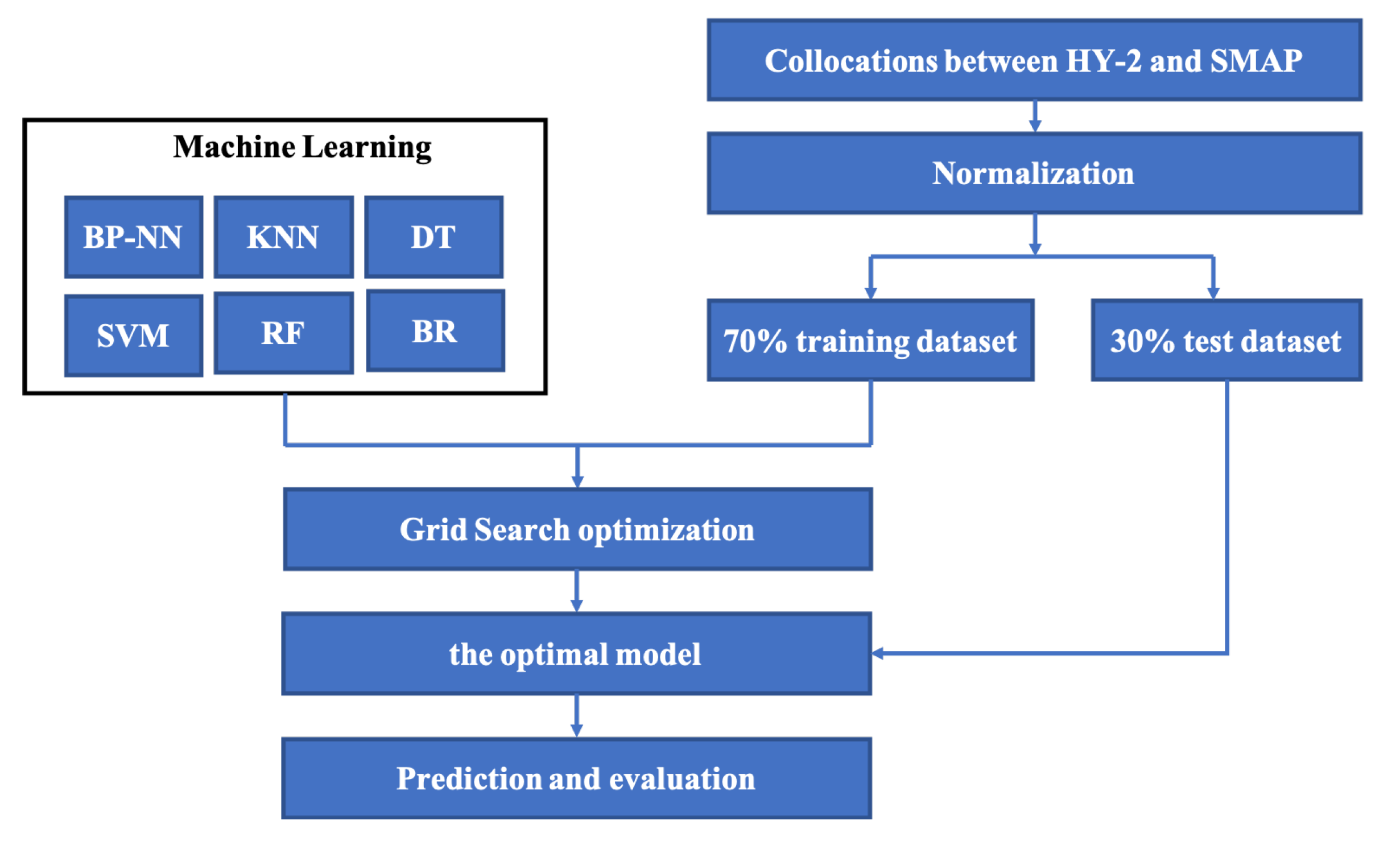

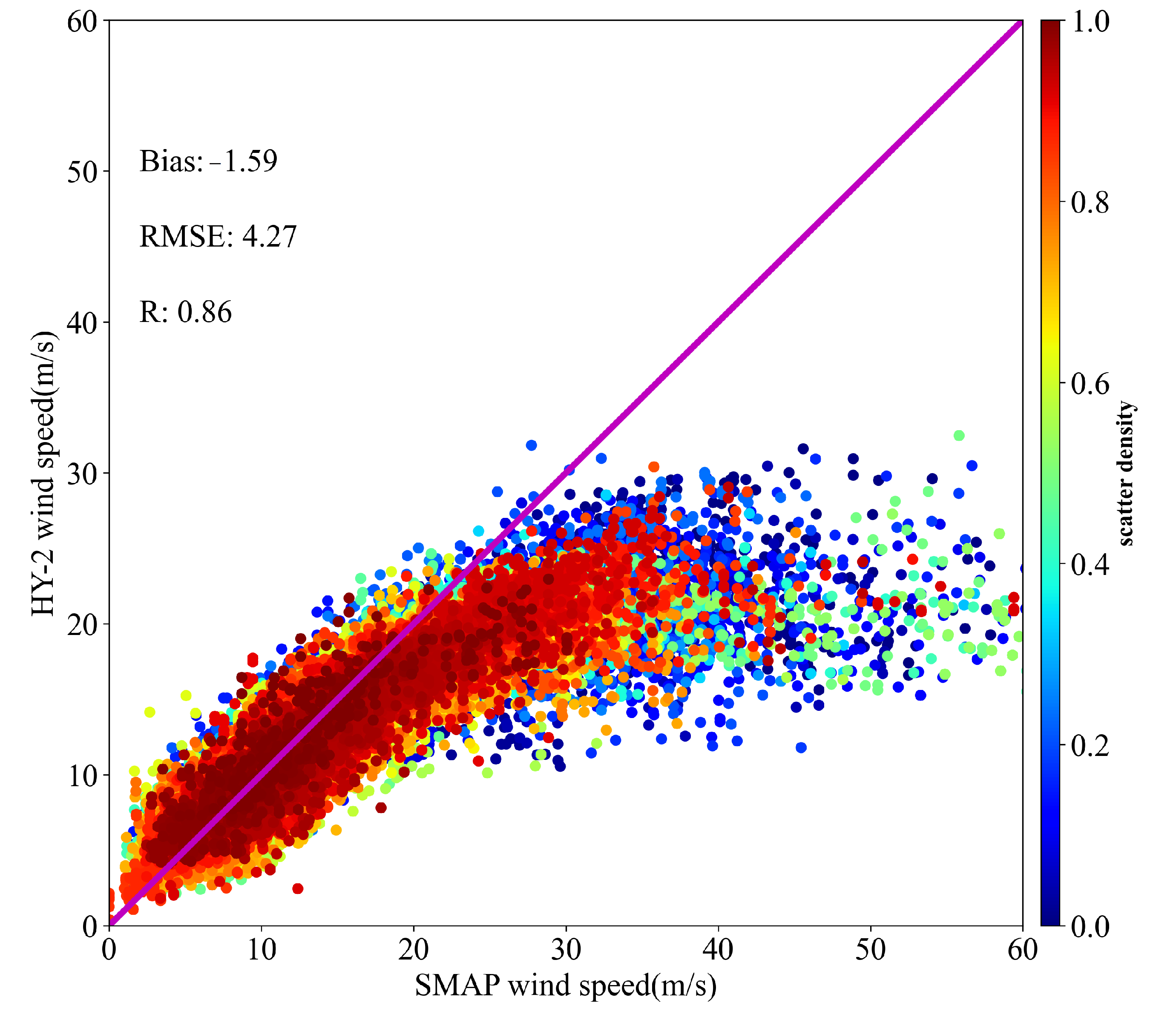
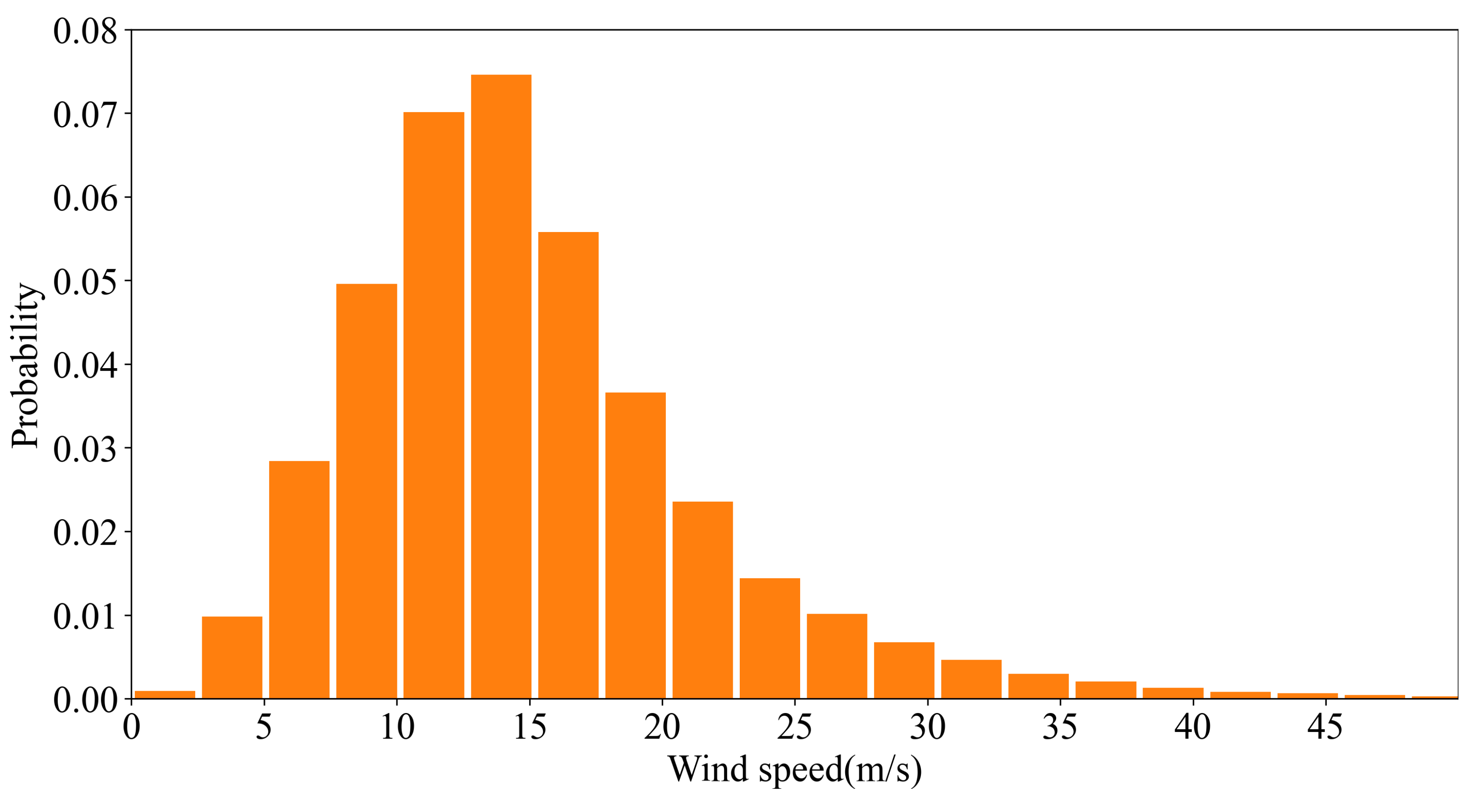
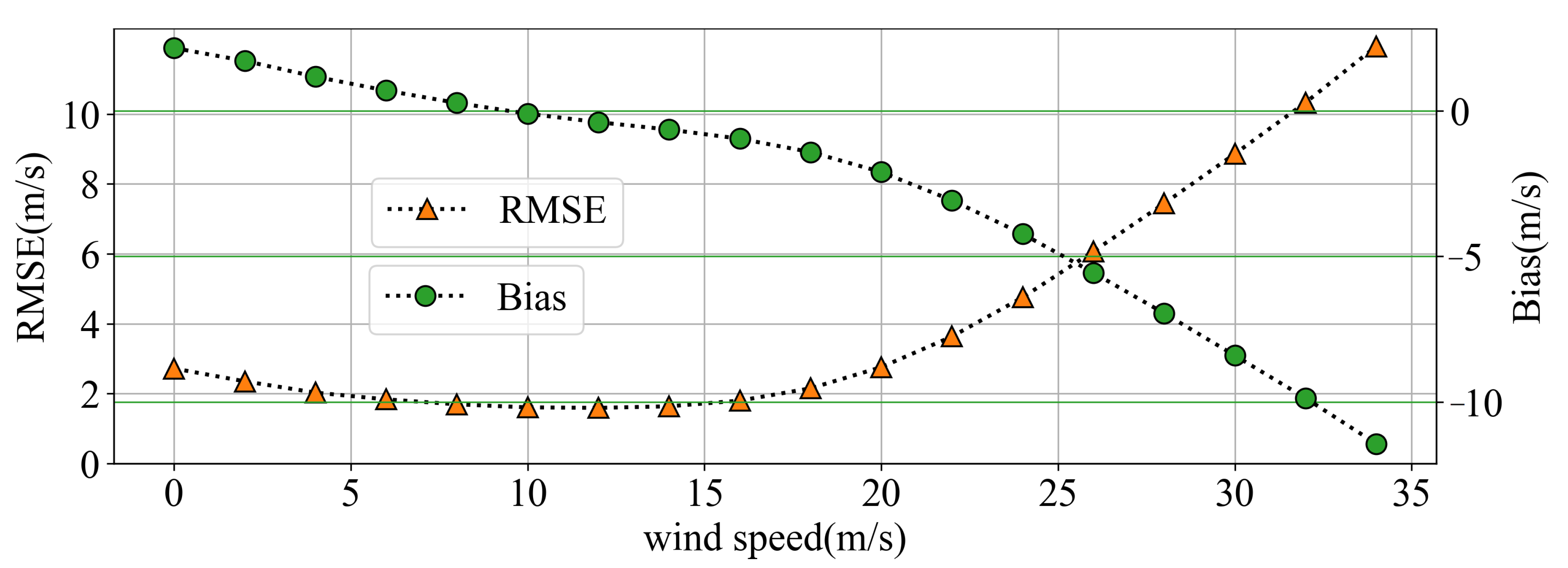
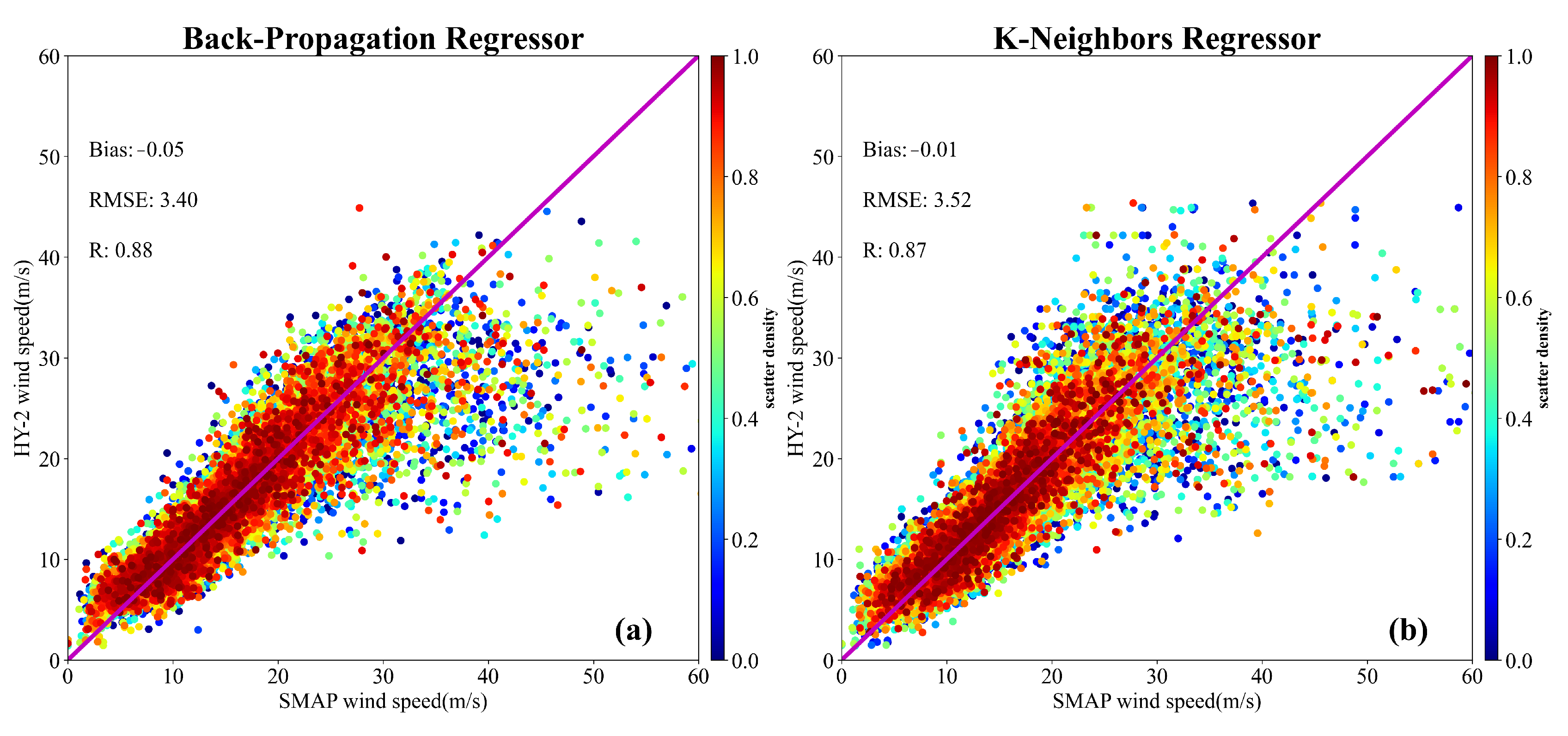
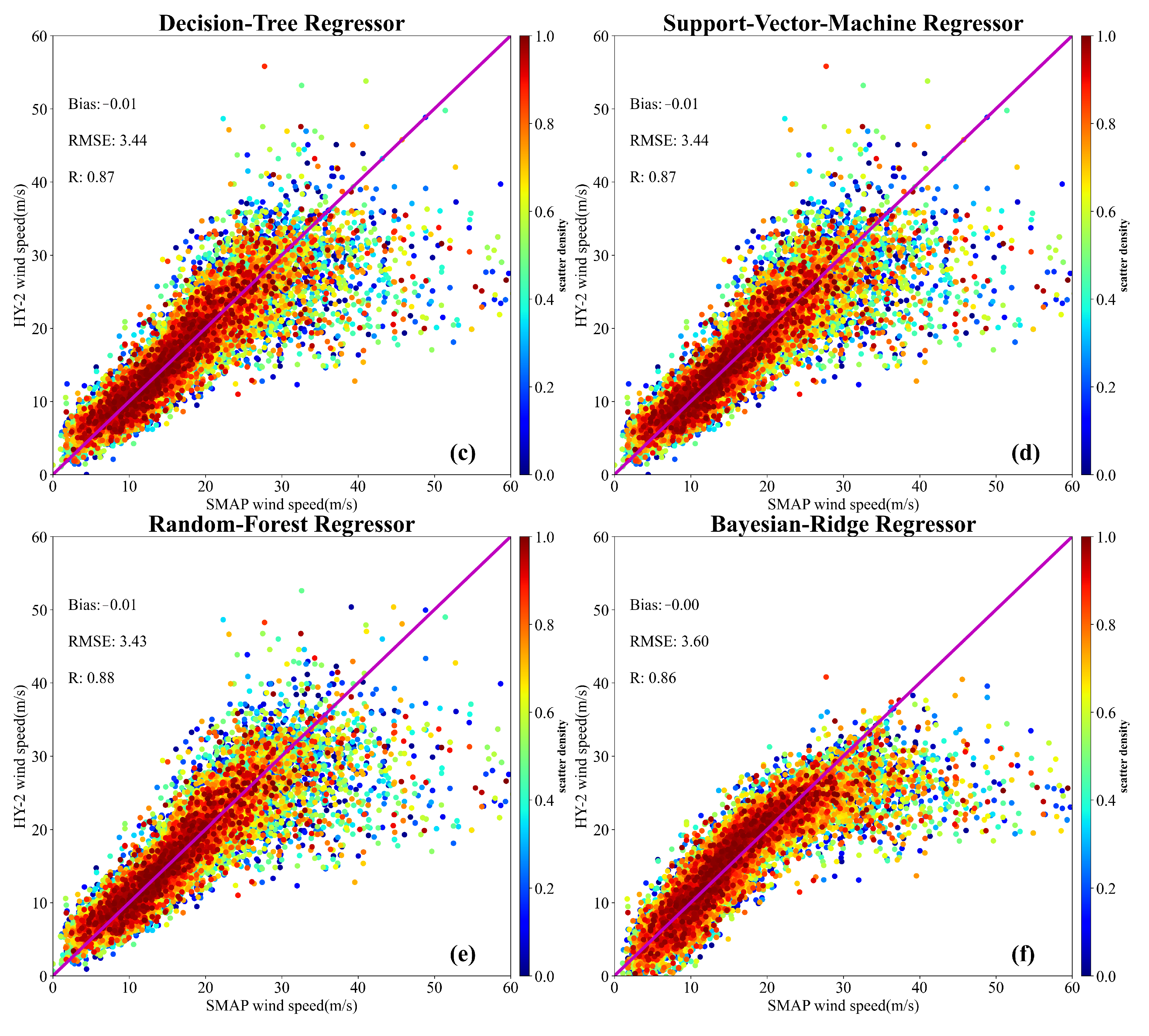
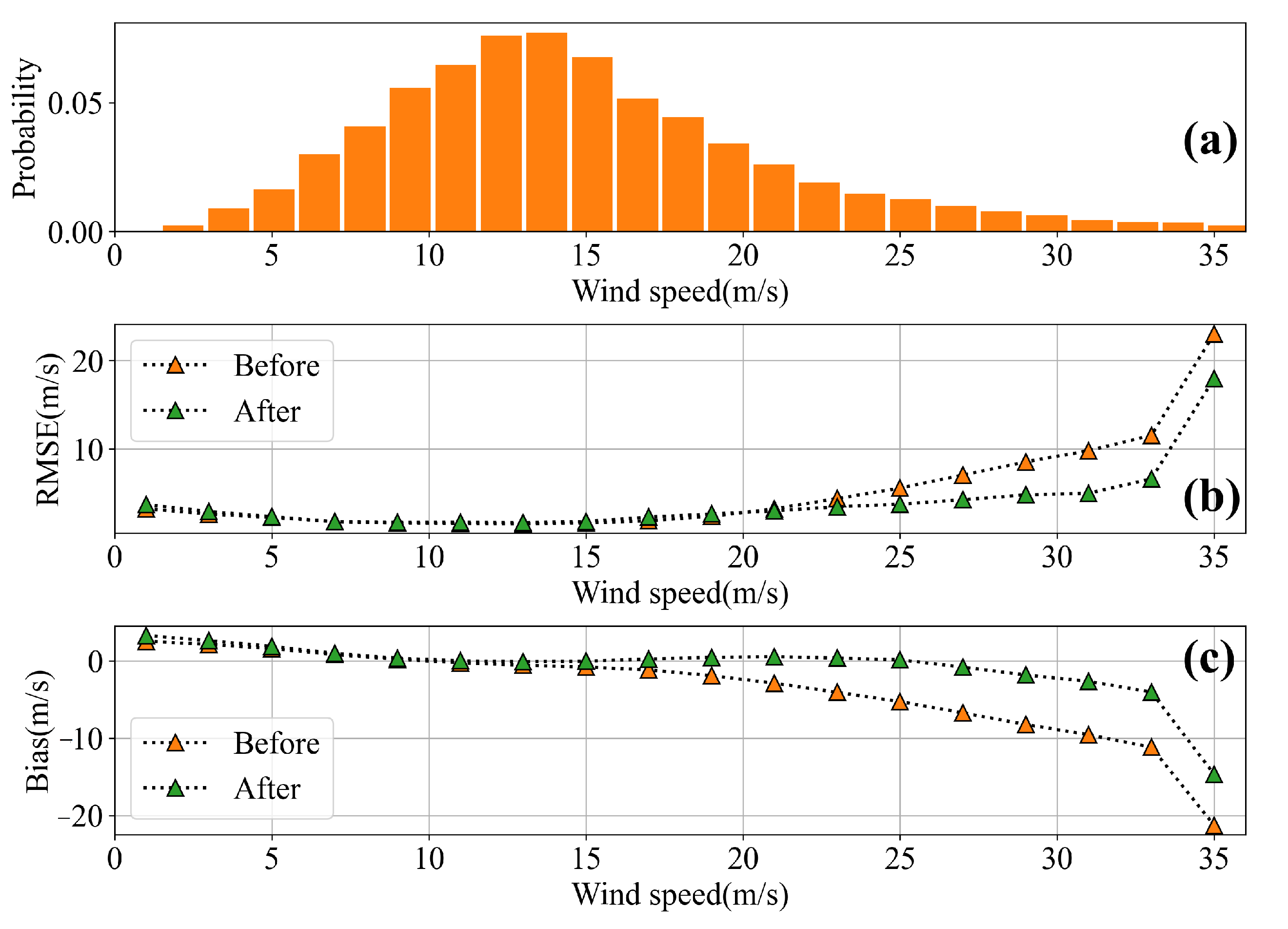
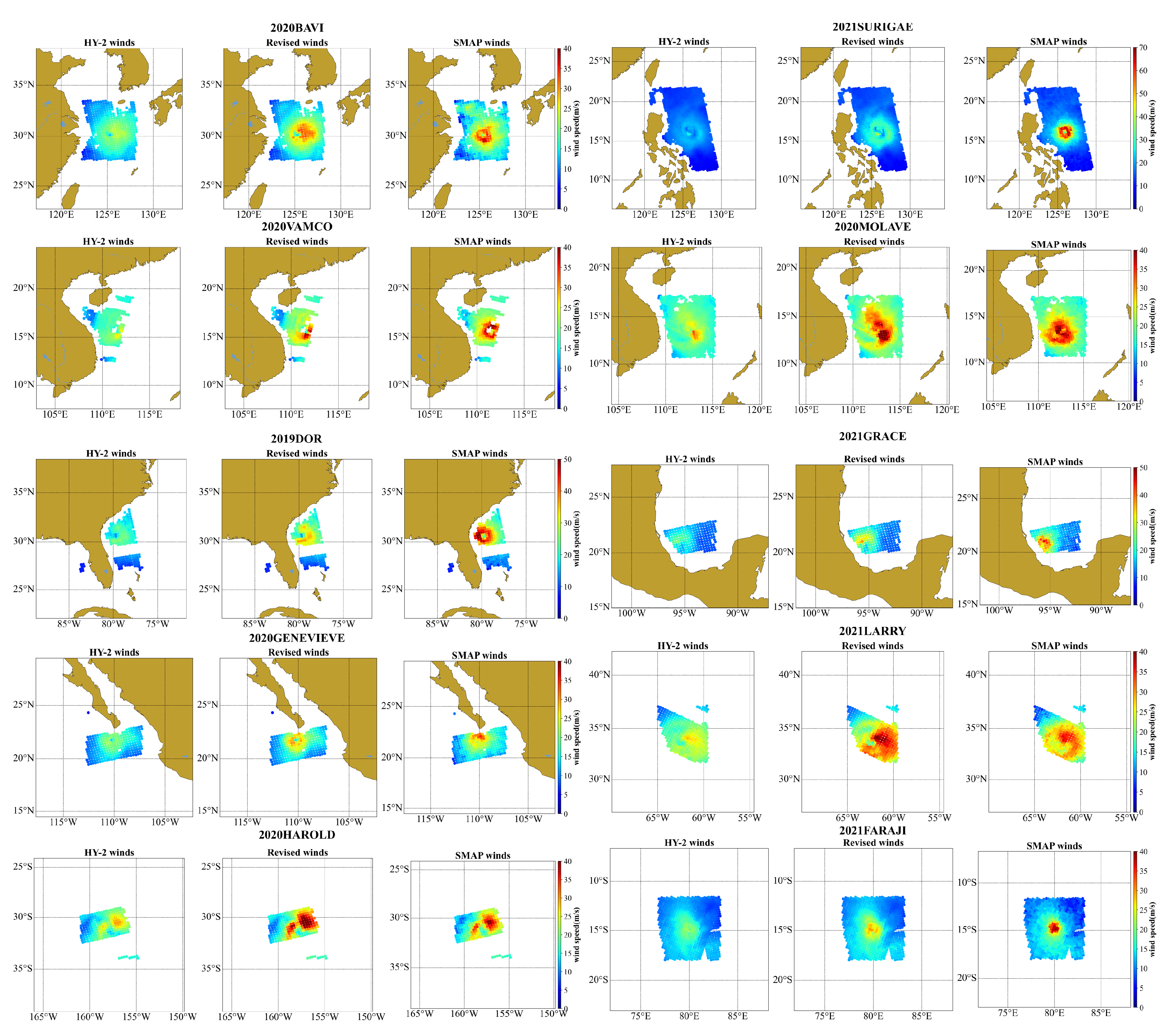
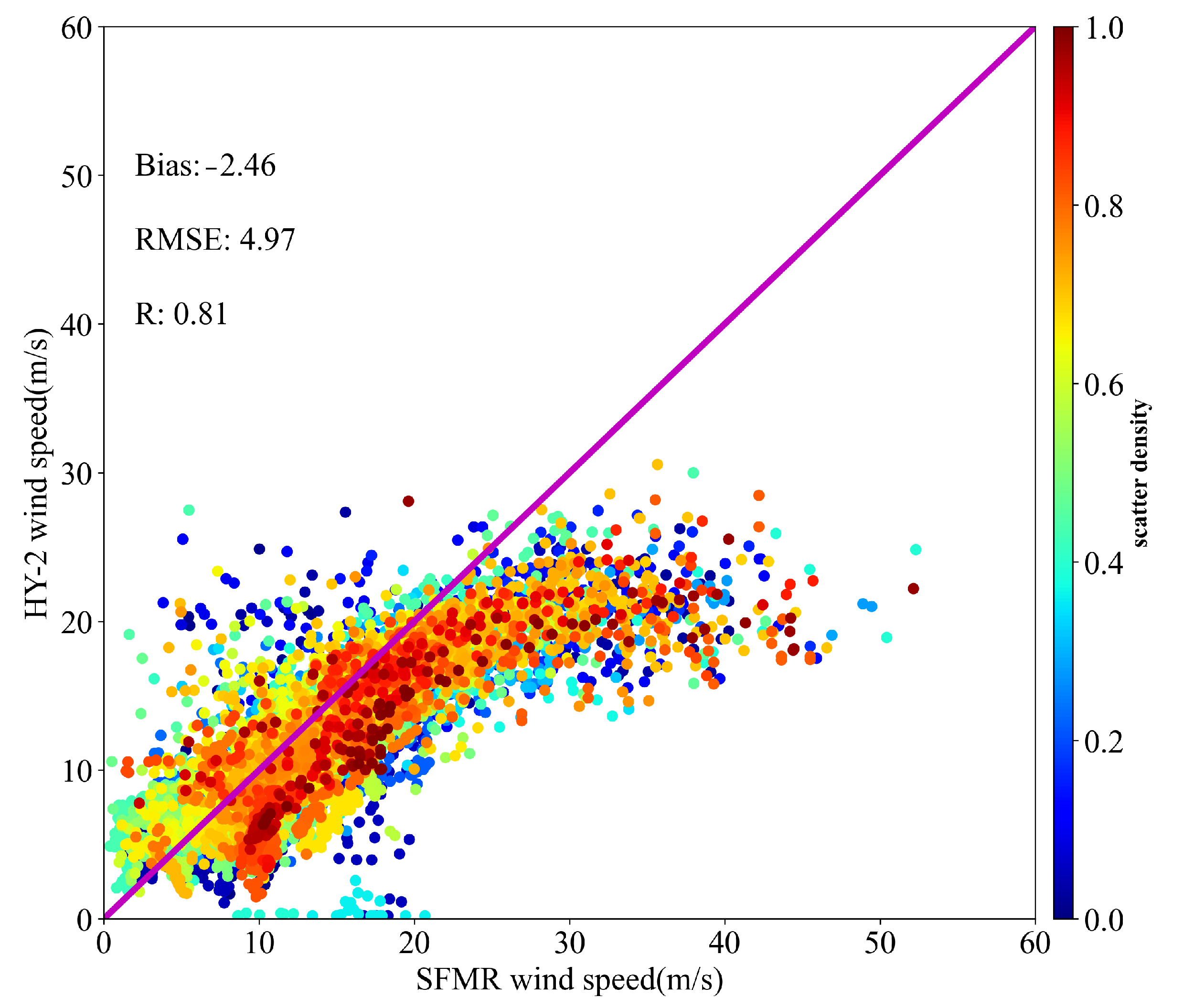
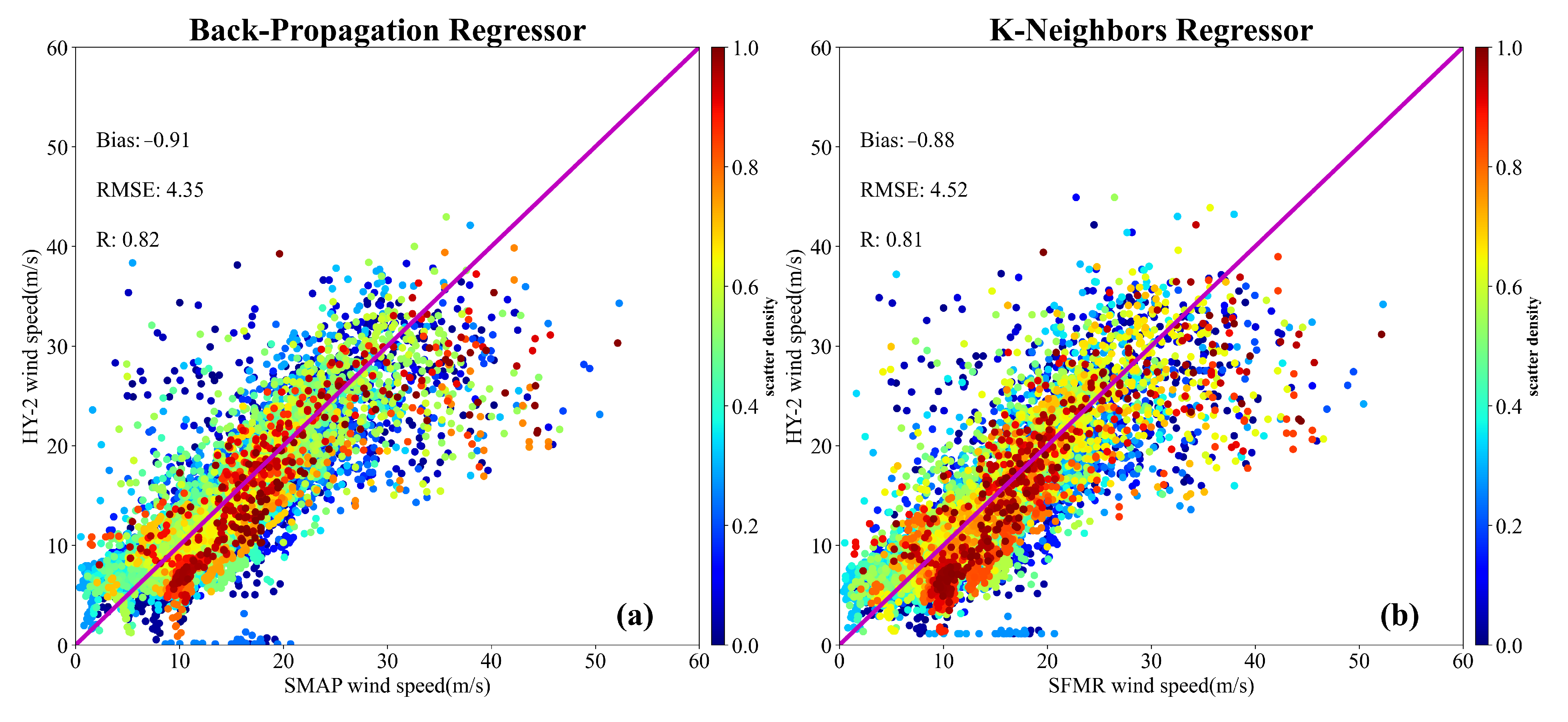
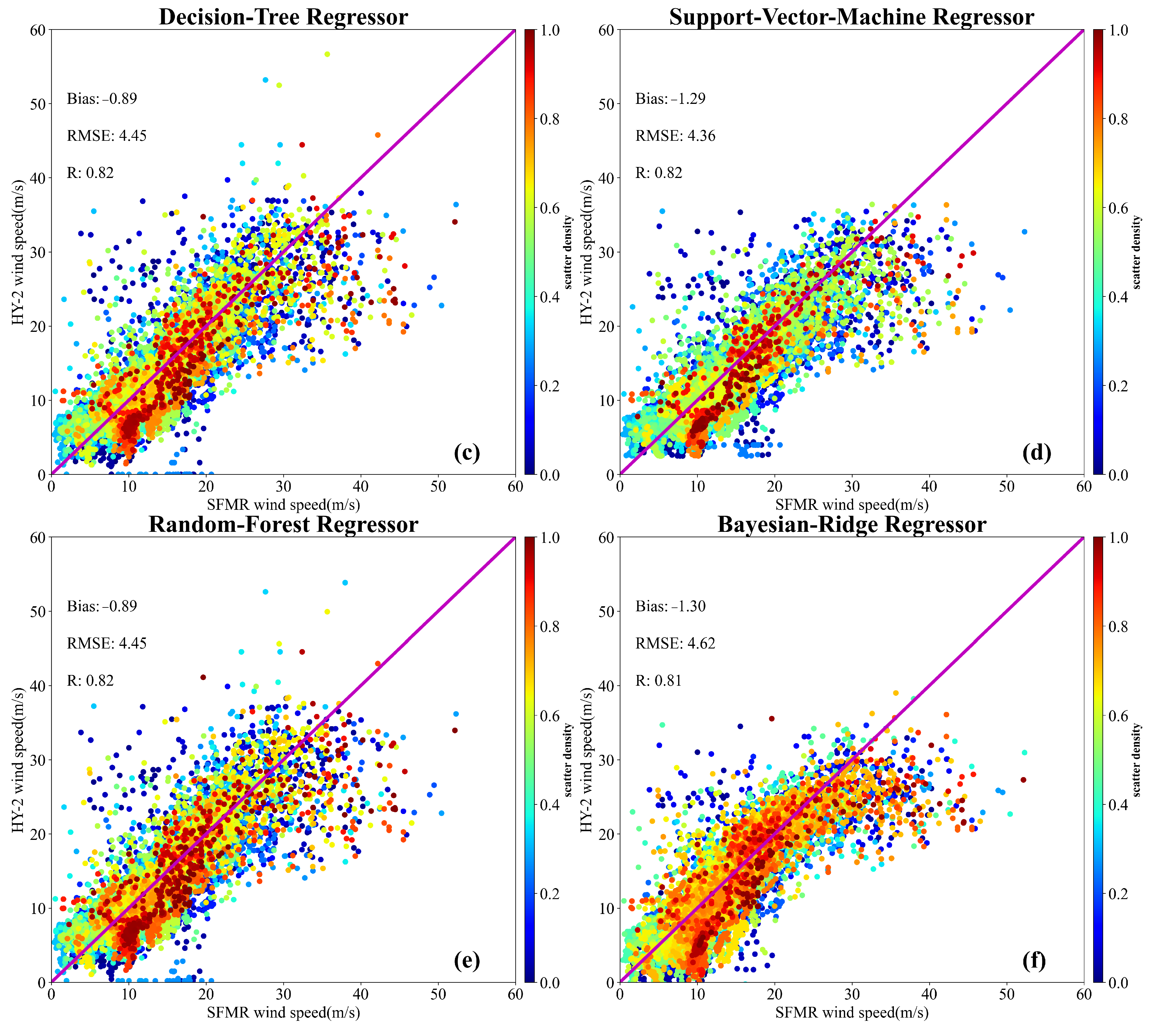

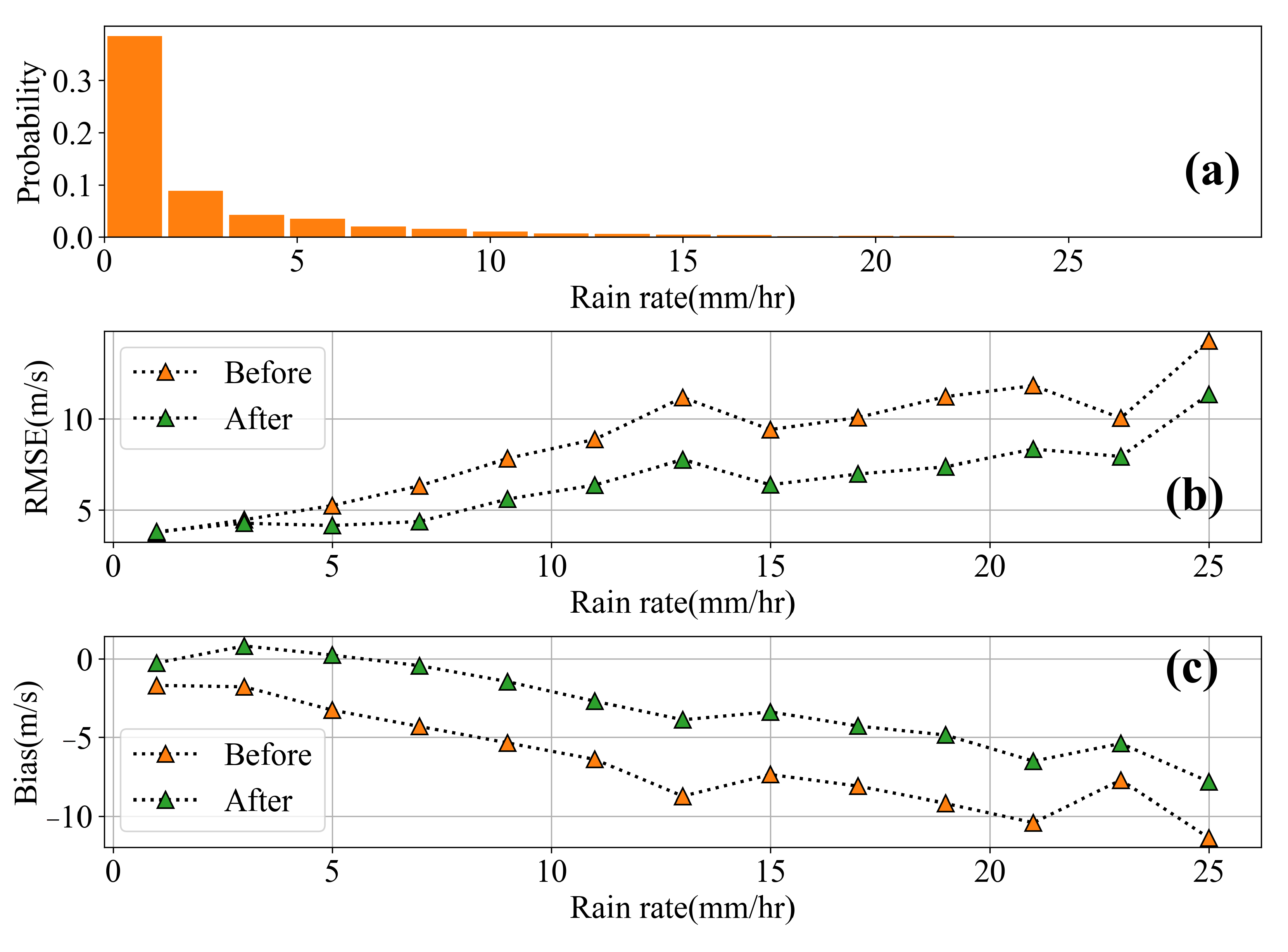
| HY-2A | HY-2B | HY-2C | HY-2D | |
|---|---|---|---|---|
| Launch time | 16 August 2021 | 25 October 2018 | 21 September 2020 | 19 May 2021 |
| Platform orbit | Sun-synchronous | Sun-synchronous | Sun-synchronous | Sun-synchronous |
| Orbit altitude | 971 km | 980 km | 971 km | 971 km |
| Revisit period | 10 day | 10 day | 10 day | 10 day |
| Frequency | 13.256 GHz | 13.256 GHz | 13.256 GHz | 13.256 GHz |
| Bandwidth | 1 MHz | 1 MHz | 1 MHz | 1 MHz |
| Polarization | HH + VV | HH + VV | HH + VV | HH + VV |
| Antenna | Rotating pencil-beam | Rotating pencil-beam | Rotating pencil-beam | Rotating pencil-beam |
| Spatial resolution | 25 km | 25 km | 25 km | 25 km |
| Swath | 1700/1350 km | 1700/1350 km | 1700/1350 km | 1700/1350 km |
| Equator crossing time (local time zone) | 6 pm ascending /6 am descending | 6 pm ascending /6 am descending | 6 pm ascending /6 am descending | 6 pm ascending /6 am descending |
| Wind speed precision | 2 m/s or 10% | 2 m/s or 10% | 2 m/s or 10% | 2 m/s or 10% |
| Wind direction precision | 20 | 20 | 20 | 20 |
| HY-2 Satellite | Time Span |
|---|---|
| HY-2B | 3 July 2019–31 December 2021 |
| HY-2C | 25 September 2020–31 December 2021 |
| HY-2D | 24 June 2021–31 December 2021 |
| Year | Tropical Ocean | Number of Captured Tropical Cyclones | |||
|---|---|---|---|---|---|
| SMAP | HY-2B | HY-2C | HY-2D | ||
| 2019 | Atlantic Ocean | 3 | 3 | 0 | 0 |
| Western Pacific Ocean | 13 | 11 | 0 | 0 | |
| Eastern Pacific Ocean | 3 | 2 | 0 | 0 | |
| Northern Indian Ocean | 4 | 1 | 0 | 0 | |
| Southern hemisphere | 13 | 2 | 0 | 0 | |
| 2020 | Atlantic Ocean | 23 | 20 | 3 | 0 |
| Western Pacific Ocean | 15 | 11 | 4 | 0 | |
| Eastern Pacific Ocean | 11 | 10 | 0 | 0 | |
| Northern Indian Ocean | 3 | 0 | 0 | 0 | |
| Southern hemisphere | 28 | 21 | 5 | 0 | |
| 2021 | Atlantic Ocean | 15 | 14 | 7 | 4 |
| Western Pacific Ocean | 17 | 11 | 4 | 8 | |
| Eastern Pacific Ocean | 15 | 13 | 6 | 5 | |
| Northern Indian Ocean | 4 | 3 | 1 | 0 | |
| Southern hemisphere | 23 | 20 | 7 | 1 | |
Publisher’s Note: MDPI stays neutral with regard to jurisdictional claims in published maps and institutional affiliations. |
© 2022 by the authors. Licensee MDPI, Basel, Switzerland. This article is an open access article distributed under the terms and conditions of the Creative Commons Attribution (CC BY) license (https://creativecommons.org/licenses/by/4.0/).
Share and Cite
Li, X.; Yang, J.; Wang, J.; Han, G. Evaluation and Calibration of Remotely Sensed High Winds from the HY-2B/C/D Scatterometer in Tropical Cyclones. Remote Sens. 2022, 14, 4654. https://doi.org/10.3390/rs14184654
Li X, Yang J, Wang J, Han G. Evaluation and Calibration of Remotely Sensed High Winds from the HY-2B/C/D Scatterometer in Tropical Cyclones. Remote Sensing. 2022; 14(18):4654. https://doi.org/10.3390/rs14184654
Chicago/Turabian StyleLi, Xiaohui, Jingsong Yang, Jiuke Wang, and Guoqi Han. 2022. "Evaluation and Calibration of Remotely Sensed High Winds from the HY-2B/C/D Scatterometer in Tropical Cyclones" Remote Sensing 14, no. 18: 4654. https://doi.org/10.3390/rs14184654
APA StyleLi, X., Yang, J., Wang, J., & Han, G. (2022). Evaluation and Calibration of Remotely Sensed High Winds from the HY-2B/C/D Scatterometer in Tropical Cyclones. Remote Sensing, 14(18), 4654. https://doi.org/10.3390/rs14184654





